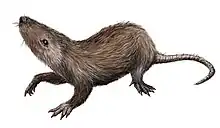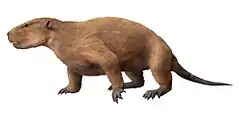| Kogaionidae Temporal range: Late Cretaceous-Eocene | |
|---|---|
 | |
| Skull of Barbatodon transylvanicus | |
| Scientific classification | |
| Domain: | Eukaryota |
| Kingdom: | Animalia |
| Phylum: | Chordata |
| Class: | Mammalia |
| Order: | †Multituberculata |
| Suborder: | †Cimolodonta |
| Family: | †Kogaionidae Râdulescu and Samson 1996 |
| Genera | |
Kogaionidae is a family of fossil mammals within the extinct order Multituberculata. Representatives are known from the Upper Cretaceous and the Paleocene of Europe.[2][3] Having started as island endemics on Hateg Island during the Upper Cretaceous, where they were in fact the dominant mammal group and diverged into rather unique ecological niches, they expanded across Europe in the Paleocene, where they briefly became a major component of its mammal fauna before their extinction.[4] They are considered to be basal members of Cimolodonta.[5]
Classification
This family is part of the suborder Cimolodonta, generally accepted as closely related to Taeniolabidoidea.[6]
These small multituberculates were named by Rădulescu R. and Samson P. in 1996, who stated they
- "Share with Taeniolabidoidea the general shape of the skull, with anterior part of zygomatic arches directed roughly transversely and very short basicranial region, which gives the skull a square-like appearance, but differ from them in having a strongly elongated snout and different dentition," (Kielan-Jaworowska & Hurum 2001, p.418).
Recent studies have favoured a position close to Taeniolabidoidea.[6] A 2021 study found them to be the amongst the most basal members of Cimolodonta, more derived only than Bryceomys, and they probably originated from an eobaatarid-like ancestor.[5]
Biology
Like some modern rodents and shrews, at least some kogaionids had red, iron-pigmented enamel. In Barbatodon this distribution is more similar to that seen in shrews as opposed to the condition seen in rodents, and suggests insectivore habits. This is a unique evolutionary route taken in the isolation of their island environment, almost entirely deprived of competing mammals, and inadvertently resulted in their survival across the KT event.[6]
In Litovoi tholocephalos, there was an extreme brain size reduction, displaying one of the smallest brains in proportion to body size of any derived mammal. Additionally, it bore a small dome in its head, like a pachycephalosaur.
Range
Kogaionids first appear as island endemics on Maastrichtian Romania, then isolated from the rest of Europe. They are in fact the only European multituberculates from the Late Cretaceous, in contrast to the Early Cretaceous' massive multituberculate diversity in Britain and the Iberian Peninsula.[4] A supposed kogaionid is also known from the Campanian of Appalachia, but its identity as a kogaionid is ambiguous and rather unlikely considering the otherwise Hateg Island-restricted range.[7]
Perhaps due to their insectivorous habits,[6] kogaionids managed to survive the KT event. During the Paleocene Hateg Island connected to the rest of Europe, and so these multituberculates dispersed; fossils are known in France, Spain and Belgium, beside Romania's Paleocene deposits at Jisou. For a brief period of time these were among the most common mammals in Europe, but by the Late Paleocene the arrival of other multituberculate groups from North America brought a quick decline, culminating in its extinction at the PETM.[4]
References
- Rădulescu and Samson (1996), "The first multituberculate skull from the Late Cretaceous (Maastrichtian) of Europe (Hateg Basin, Romania)". Anuarul Institutului de Geologie al României, Supplement 1 69, p. 177-178.
- Kielan-Jaworowska Z & Hurum JH (2001), "Phylogeny and Systematics of multituberculate mammals". Paleontology 44, p. 389-429.
- Much of this information has been derived from MESOZOIC MAMMALS: "basal" Cimolodonta, Cimolomyidae, Boffiidae and Kogaionidae, an Internet directory.
- ↑ Zoltán Csiki-Sava; Mátyás Vremir; Jin Meng; Stephen L. Brusatte; Mark A. Norell (2018). "Dome-headed, small-brained island mammal from the Late Cretaceous of Romania". Proceedings of the National Academy of Sciences of the United States of America. 115 (19): 4857–4862. Bibcode:2018PNAS..115.4857C. doi:10.1073/pnas.1801143115. PMC 5948999. PMID 29686084.
- ↑ Campomanes, P. PelÁez; N. LÓpez-MartÍnez; M.A. Álvarez-Sierra; R. Daams (July 2000). "The Earliest Mammal of the European Paleocene: The Multituberculatehainina". Journal of Paleontology. 74 (4): 701–711. doi:10.1666/0022-3360(2000)074<0701:temote>2.0.co;2. S2CID 28165959.
- ↑ Codrea, Vlad; Smith, Thierry; Dica, Paul; Folie, Annelise; Garcia, Géraldine; Godefroit, Pascal; Van Itterbeeck, Jimmy (2002). "Dinosaur egg nests, mammals and other vertebrates from a new Maastrichtian site of the Haţeg Basin (Romania)" (PDF). Comptes Rendus Palevol. 1 (3): 173–180. Bibcode:2002CRPal...1..173C. doi:10.1016/S1631-0683(02)00021-0. ISSN 1631-0683.
- 1 2 3 First mammal species identified from the Upper Cretaceous of the Rusca Montana Basin (Transylvania, Romania) Article in Comptes Rendus Palevol https://dx.doi.org/10.1016/j.crpv.2016.04.002 · June 2016 doi:10.1016/j.crpv.2016.04.002
- 1 2 Smith, Thierry; Codrea, Vlad A.; Devillet, Ghéreint; Solomon, Alexandru A. (2021-09-24). "A New Mammal Skull from the Late Cretaceous of Romania and Phylogenetic Affinities of Kogaionid Multituberculates". Journal of Mammalian Evolution. 29: 1–26. doi:10.1007/s10914-021-09564-7. ISSN 1064-7554. S2CID 244194193.
- 1 2 3 4 Thierry Smith, Codrea Vlad, Red Iron-Pigmented Tooth Enamel in a Multituberculate Mammal from the Late Cretaceous Transylvanian " Haţeg Island ", Article in PLoS ONE 10(7):e0132550-1-16 · July 2015 doi:10.1371/journal.pone.0132550
- ↑ Paleobiogeographical implications of the fossil mammals from the Maastrichtian of the Hateg Basin Article · January 2002

